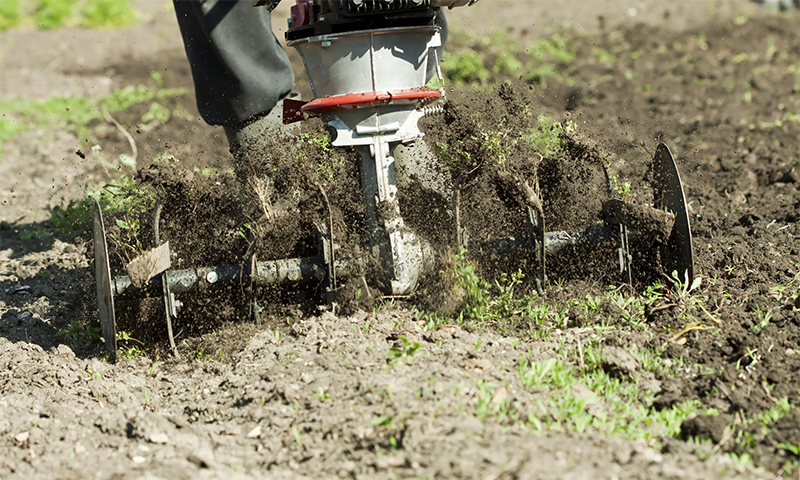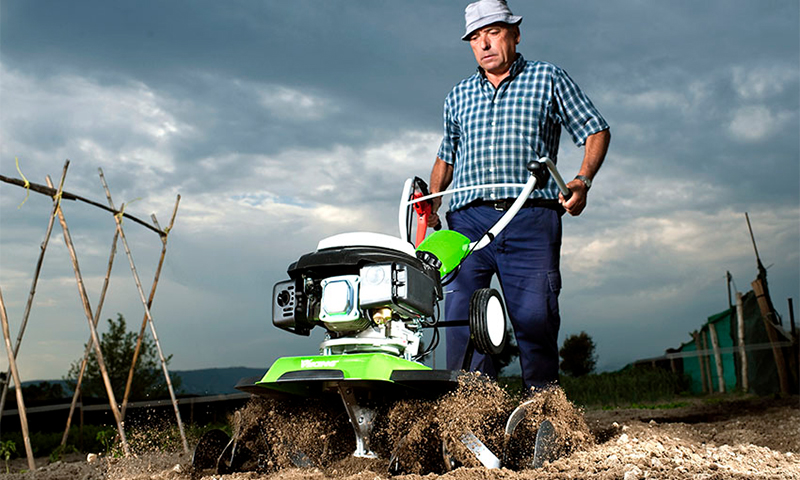To facilitate the work in the garden by using a cultivator. This is a small garden equipment, which is able to perform the same work as the walk-behind tractor, but in a smaller area. Using the device it will turn out to plow virgin soil, grind the soil under the breakdown of the beds, weed the soil from the weeds, plant and harvest. Models of cultivators differ in weight, speed, engine and price. This article will teach you to pick up equipment in accordance with the required tasks and the size of the land.
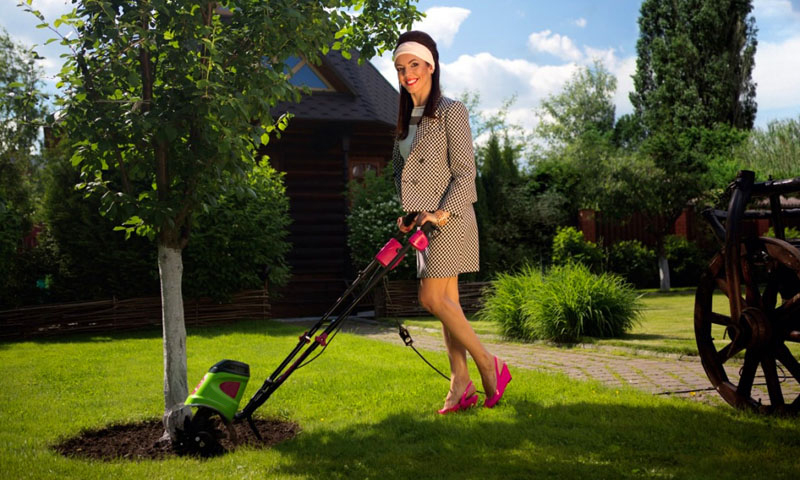
Content:
The best manufacturers of cultivators - which company to choose
If you are too lazy to delve into the differences in cultivators, then you can purchase a quality product from any of the following companies:
- Champion;
- Daewoo;
- Huter;
- Hyundai;
- Carver.
But given the different possibilities for the cultivated area, as well as the level of ease of use, it is worth reading top cultivators rating. This article will help you choose the cultivator competently and determine the appropriate value of each parameter for you personally.
The principle of operation and the device cultivator
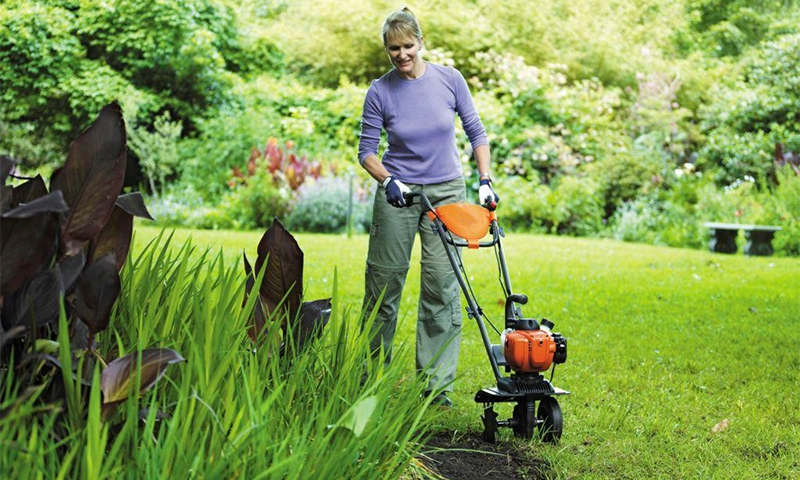
The cultivator is a small frame with a power unit and a shaft with located inventory (mill, plow). The handles are pulled back like those of a wheelbarrow, holding onto which the work begins.
With it, you can quickly perform basic processes for the development and maintenance of the soil, as well as planting and harvesting. On some models there is the possibility of connecting the cart and moving as in the vehicle along with the crop.
In contrast to the tiller, the cultivator does not have a power take-off shaft, and the capabilities of the power unit are much more modest. For example, with the help of a motoblock, you can process areas up to 4 Ha, and the cultivator is designed for up to 30-40 hectares.
Another difference is the absence of a coup lump. The cultivator raises, shatters and shakes the ground, but the reservoir remains in its horizontal position.
The compact garden equipment is used both at the preparatory stages of the soil, and for tilled purposes, with the already planted crops.
With it you can:
1. Dig up the virgin soil.
2. Loosen the formed crust.
3. Remove weeds.
4. Finely grind the surface to preserve moisture and close the cracks.
5. Spud plant trunks.
Depending on the required actions, the cultivators are supplied with the following suspension equipment:
1. Mill with curved ends;
2. Center discs;
3. Lancet paws that work by pulling;
4. Ploughshare - sharp tip of the plow;
To perform various works, the technician has a mandatory number of components and parts:
1. Frame;
2. Power unit for 2 or 4 cycles;
3. Fuel tank (in the case of the gasoline model);
4. The handle with gas bracket;
5. Rotor for fixing discs and cutters;
6. Wheels (can be from one to three);
7. Bracket for mounting other devices (trolley, hiller).
Types of cultivators
Petrol
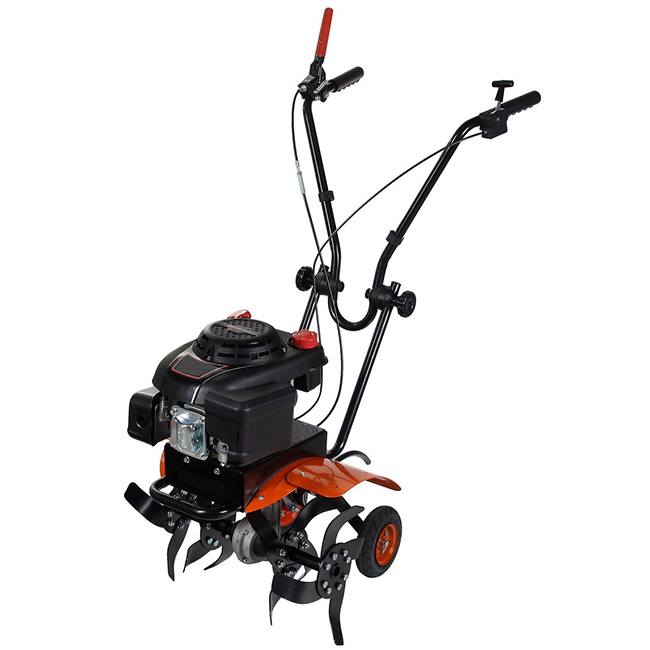
They are distinguished by their autonomy, which allows them to be used on spacious plots or in the fields, far from home. Work with the internal combustion engine. Have a large range of power and cost. Suitable for large gardens or professional farming.
Advantages:
- high power;
- various parameters for the width of plowing;
- suitable for the development of virgin soil;
- chain gear well transmits rotation;
- varied value;
- wheel alignment;
- reliable.
Disadvantages:
- loud noise;
- fuel and oil costs;
- heavy weight;
- emissions into the atmosphere, which is unacceptable in the greenhouse.
Electric

Differ in smaller mass, high performance, lack of loud sounds. Their rotation is provided from the mains supply in 220V. To work it is necessary to carry in the 30-60 meters, depending on the size of the site and distance from the house. They are used in the country or in the private sector to process gardens of sizes up to 10 acres.
Advantages:
- the price is lower than that of gasoline;
- engine power range from 0.6 kW to 5.5 kW;
- simple operation;
- you can plow the land up to 250 mm in depth;
- compact size;
- a light weight;
- There are very narrow and medium width models.
Disadvantages:
- the presence of a wire is required and the distance from the house is limited;
- during the work it is necessary to pay special attention not to break the cable;
- not suitable for large gardens.
Rechargeable
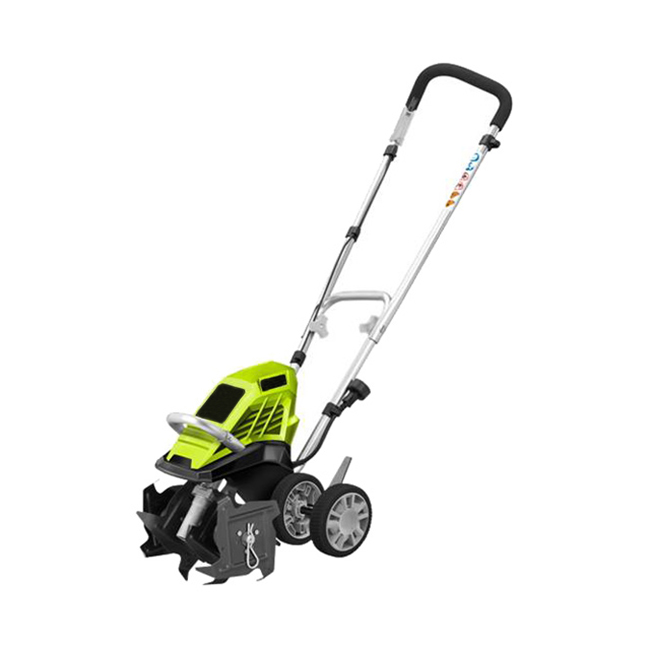
Differs in completely autonomous work from the attached battery. They have a lightweight kit, which is convenient for use by women and the elderly. The absence of wires allows you to not think about extraneous things and fully focus on your favorite hobby.
Environmentally friendly, and suitable for greenhouses or small beds under the house, so that each time not to carry the carrier.
Advantages:
- autonomous work;
- no sound;
- no exhaust;
- lightweight body;
- convenient to use the elderly and women;
- plowing depth up to 200 mm;
- acceptable power;
- sufficient width of 260-300 mm.
Disadvantages:
- running time is limited by battery capacity;
- the price is much higher electric;
- suitable only for small greenhouses or beds.
Cultivator Selection Parameters

engine's type
Two types of engines are common:
1. Fuel - runs on gasoline. May have two or four bars. It is distinguished by a loud sound and exhaust emissions. Its power allows deep plowing up the soil, uprooting the roots of weeds and grinding compacted layers. This type should be chosen for plowing virgin soil, work in the field, a large vegetable garden over 15 acres.
2. Electric - powered by 220V or battery. Almost silent, has a smaller mass, there is no additional cost of fuel. No emissions. It is bought in the case of work in a large greenhouse or small garden next to the house.
Power
Depending on the type of engine is indicated in horsepower or kW. Power affects performance and area to be processed. If there is a discrepancy, weak devices will quickly go out of order, and strong ones on a small piece of land will stand idle, and this will also lead to cost overruns at the time of purchase.
1. Varies power rating from 1.1 to 7 hp or 0.6-5.2 kW.
2. To work in the greenhouse, the breakdown of the beds in the country, enough of the minimum values of 1-2 hp or 0.6-1.5 kW.
3. To process a personal plot of 10 acres will turn out with an average of 4 hp or 2-3 kW.
4. Large fields need units with 6-7 hp. or 4-5 kW.
The increase in power complicates management manipulations and requires physical strength and preparation; therefore, such models must be abandoned by women or elderly people.
Processing width
The range of this characteristic can be from 180 mm to 1050 mm.
1. Values of 180-350 mm are quite enough for the treatment of flowerbeds near the house, the maintenance of narrow areas in the greenhouse or the care of beds in the yard. Large performance is not needed because of the limited space and the required maneuverability.
2. Spacious field or a rectangular garden in the country in the 15 hectare more convenient and faster to handle a wide arrangement of cutters in the 700-1000 mm. Movement in a straight line and sufficient place on the side of the road for turning will allow easy handling with equipment moved apart at the edges.
Plowing depth
How far it goes to penetrate the soil of the mill depends on its diameter. Devices may be designated by the depth of plowing from 110 mm to 350 mm.
1. The minimum values are suitable for preparing the soil for crops with a small root system (onions, carrots, strawberries, parsley, tomatoes).
2. Parameters from 150 to 200 mm are suitable for planting potatoes, soil loosening and hilling.
3. Devices with a maximum value of 350 mm are required only for plowing virgin soil, where weed roots have grown deep and must be removed. Planting cultivated plants to such depth will lead to their slow growth and difficulties during harvesting.
Number of speeds
Cultivators can move at different speeds and in several directions.
Here are the varieties available and their uses:
1. 1 forward - allows you to work out the necessary area, but, reaching the edge, requires pulling the plows by hand, which is suitable for physically trained people. If the depth of penetration into the soil is minimal (110 mm), then a woman will cope with this. Such models are desirable to use in small greenhouses or open beds.
2. 1 forward and 1 back give convenience when reaching the edge of the section where you can turn on the rear speed, drive the mill out of the depth, turn around and continue on the new lane. Practical for small gardens with a fence, in the country, where there is limited space for turning.
3. 2 forward and 2 backward - have good maneuverability, and when the cutter is pulled out and rotated at different speeds back and forth, it will be easy to clean the metal elements from the wound roots. This is practical for plowing up virgin or large vegetable gardens, where many weeds have time to grow.
4. 3 forward and 1 backward is the most functional cultivator, which is capable of plowing rammed soil at low revs, quickly dig furrows for planting vegetables at medium speed, and grind fine soil for cutting beds for seeds, which is done at elevated revolutions.
Mass of the device
The weight of a cultivator can vary from 7 to 93 kg. This is directly related to its power and functionality: the greater the mass, the wider the possibilities of technology. But it also affects the ease of use of garden equipment.
1. Women on small beds or greenhouses are easier to handle with models from 7 to 15 kg. The same indicator is recommended for older people.
2. Gardens in the country and private houses, an area of about 15 acres, are processed models from 15 to 30 kg. This work is done by adult men.
3. Professional activities on the farm and large areas require equipment weighing from 30 kg with the possibility of additional equipment being hung.
Which cultivator to choose
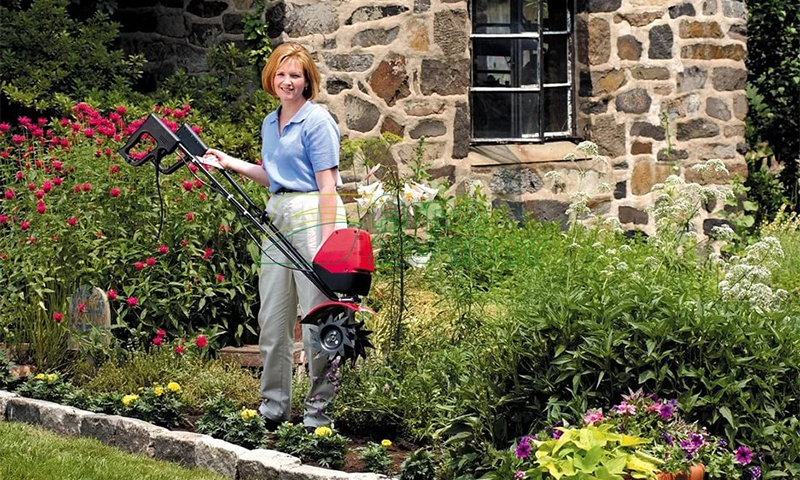
1. To maintain the garden in the country with the size of 10 acres and fenced, you will need garden equipment with 1 front and 1 rear speed, weighing 15 kg, powered by 220V electricity. There will be enough power of 3-4 kW, processing width of 500-600 mm, penetration depth of 150 mm. Work will have to be carried in 50 meters.
2. To break the greenhouse or cut the beds near the house, you need an electric cultivator, possibly with batteries. A small mass of 7-9 kg will require only one front speed and manual excavation when reaching the edge. Power required minimum up to 1-1,5 kW, with a plowing depth of 195 mm and a width of 260 mm.
3. It is convenient to handle a large vegetable garden with a unit weighing 20 kg, a gasoline engine, 2 front and 2 rear speeds, a processing width of 700-1000 mm and a depth of 200-250 mm. This will require a power of 5 hp.
4. For professional farming or servicing a problematic swampy area with stones, you need a device with three front and one rear speeds, a gasoline powertrain, weighing 30-40 kg, width of the location of the mills 900-1050 mm, power 6-7 hp, plowing depth 200 mm for well-groomed land or 350 for developing a new field.
How much is a cultivator

1. The device for giving will cost 4800-10000 rubles.
2. The battery model for working in the greenhouse costs 12,000 rubles.
3. To maintain a large garden will have to pay 9000-14000 rubles.
It will be interesting to friends too




